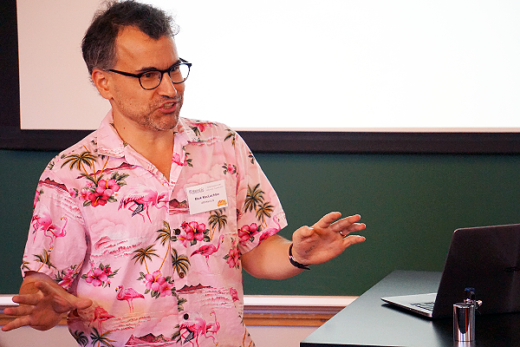Biocompatible tips for chemically probing living cells
AFM tips functionalized with innovative cellulose nanocrystals offer ultra-low invasive insights into the chemical composition of living cells

Mark MacLachlan, Professor, Nano Life Sciences Institute (WPI-NanoLSI), Kanazawa University
Mark MacLachlan is one of four overseas-based principal investigators (PIs) at the NanoLSI WPI Kanazawa University with active research groups at The University of British Columbia, Canada and Kanazawa working to achieve the goals of the WPI program.
“My expertise is in supramolecular materials chemistry,” says MacLachlan. “My group is active in areas including synthesis and self-assembly of ring-shaped molecules. We explore these for sensing and assembly into hierarchical structures. We also have projects on creating materials from cellulose nanocrystals, which are materials extracted from wood products, and we have been developing materials based on waste crab and shrimp shells.”
COVID-19 pandemic and research activities: “The longest I’ve been on Earth for many years.”
Global restrictions on movement introduced in the Spring of 2020 have affected MacLachlan’s research activities, but he has adapted to alternative ways of interacting with his colleagues locally in Vancouver and further afield in Kanazawa. “It’s been pretty challenging over the last year,” says MacLachlan. “I haven’t been on an airplane since February 2020 when I actually went to Kanazawa for three weeks, and that was my last trip. This is the longest I’ve been on Earth for many years!”
MacLachlan adds that the University of British Columbia closed all labs in March 2020 followed by partial rotation-based reopening in mid-June 2020. “Now, as we move into Feb 2021, professors can go into the into their offices occasionally, so I go in once every 2 to 3 weeks to do teleconferencing meetings from my office, but it’s nice to change the environment. Most of the time I work in my son’s bedroom where I have a little desk setup.”
Notably, MacLachlan and his colleagues still managed to publish approximately 15 papers last year despite limited access to instrumentation such as electron microscopes and mechanical measurement equipment.
Research at NanoLSI
MacLachlan is a member of the Supramolecular Chemistry Group of the WPI program at Kanazawa University where he works closely with colleagues including PIs Professors Katsuhiro Maeda and Shigehisa Akine of the same group. “We are looking at developing functionalized cellulose nanocrystals for use as unique probes for atomic force microscopy,” explains MacLachlan. “These probes will be inserted into living cells and undergo selective recognition of different biomolecules or ions in cells, which is one of the pillars of the WPI program in terms of imaging the insides of cells. This method is our contribution now.” Specific topics in progress include the development of new cellulose nanocrystal tips, new macrocycles, and synthesis of chemical sensing molecules that change color or change their fluorescent properties when they bind to specific targets.
Needless to say, imaging the insides of living cells with AFM tips is very difficult. “These experiments are like using the tip of a record player arm to poke inside of cells,” says MacLachlan. “We are interested in extracting information about the chemical structure of cells, and changing the chemical composition of our cellulose nanocrystal tips affects the speed of interaction between biomolecules in the cell, which may give us deep-insights into the ionic compositions of different regions of cells. Importantly, our approach of using cellulose—a biocompatible substance—to functionalize AFM tips is very unintrusive, potentially enabling the penetration of cells without disrupting or destroying their lipid membranes. It’s an exciting area of research and I am really looking forward to visiting Kanazawa again as soon as the restrictions on travel are lifted.”
Research highlights
Three recent publications offer a perspective into Professor MacLachlan’s research on cellulose nanocrystals. In the first, his group “stretched chiral nematic cellulose nanocrystal (CNC) elastomer composites” to tune their visible color between blue and red by mechanical elongation or compression [1]. These materials are promising as mechanical sensors and soft displays. In another report, MacLachlan and colleagues describe the preparation of highly flexible and hydrophobic chiral nematic cellulose/hydroxypropyl cellulose (CNC/HPC) composite films where the reflectivity of visible light was tuned by varying the amount of HPC in the composite [2]. The final example describes the synthesis of functional CNC gels with a rigid tetracationic macrocycle (cyclobis(paraquat‐p‐phenylene) using ion-induced gelation for potential applications including water-pollutant scavengers [3].
References
[1] Charlotte E. Boott, Andy Tran, Wadood Y. Hamad, and Mark J. MacLachlan, Cellulose Nanocrystal Elastomers with Reversible Visible Color, Angewandte Chemie International Edition, 59, 226-231, (2020). https://doi.org/10.1002/anie.201911468
[2] Christopher M. Walters, Charlotte E. Boott, Thanh-Dinh Nguyen, Wadood Y. Hamad, and Mark J. MacLachlan, Iridescent Cellulose Nanocrystal Films Modified with Hydroxypropyl Cellulose, Biomacromolecules 21 (3), 1295-1302, (2020).
https://pubs.acs.org/doi/abs/10.1021/acs.biomac.0c00056
[3] Dongjie Zhang, Miguel A. Soto, Lev Lewis, Wadood Y. Hamad, and Mark J. MacLachlan, Host–Guest Chemistry Within Cellulose Nanocrystal Gel Receptors, Angewandte Chemie International Edition, 59, 4705-4710, (2020). https://doi.org/10.1002/anie.201913030

Stretchable photonic elastomer materials made with cellulose nanocrystals (CNCs). As the material is stretched, its colour changes.

By mixing cellulose nanocrystals (CNCs) with hydroxypropylcellulose (HPC) in different ratios, flexible photonic materials can be made with colours that span the spectrum.

Further information
NanoLSI Podcasts
This episode offers greater insights into Professor Mark MacLachlan’s research at the NanoLSI.




